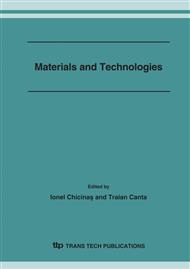p.63
p.67
p.71
p.75
p.79
p.83
p.87
p.91
p.95
Effect of Carbon Content and Post-Sintering Cooling Rate on Mechanical Properties of Fe-Ni-Cu-Mo-C High Density Sintered Steel
Abstract:
Powders-based on the Fe-Cu-Ni-Mo system are well known in the P/M industry for combining good compressibility and dimensional stability with a potential for high strength. The typical heterogeneous microstructure of these materials has proven to provide favourable mechanical properties. However, in applications where strength and hardness become critical variables, faster cooling rates after sintering are required to meet application requirements. Test specimens containing various graphite contents to achieve 0.20, 0.35 and 0.55% combined carbon were pressed to 7.0 and 7.2 g/cm3, sintered in a furnace at 1150°C and cooled directly from sintering temperature with either normal or rapid cooling. Test results are discussed in terms of tensile properties, apparent hardness and microstructure. The formation of bainite and martensite by raising carbon content and cooling rate increased tensile strength and apparent hardness, while a higher green density maintained satisfactory ductility. It was possible to achieve ultimate tensile and yield strengths as 920 and 660 MPa respectively with apparent hardness 30 HRC.
Info:
Periodical:
Pages:
79-82
Citation:
Online since:
October 2007
Authors:
Keywords:
Price:
Сopyright:
© 2007 Trans Tech Publications Ltd. All Rights Reserved
Share:
Citation:


